Red Birds of Georgia
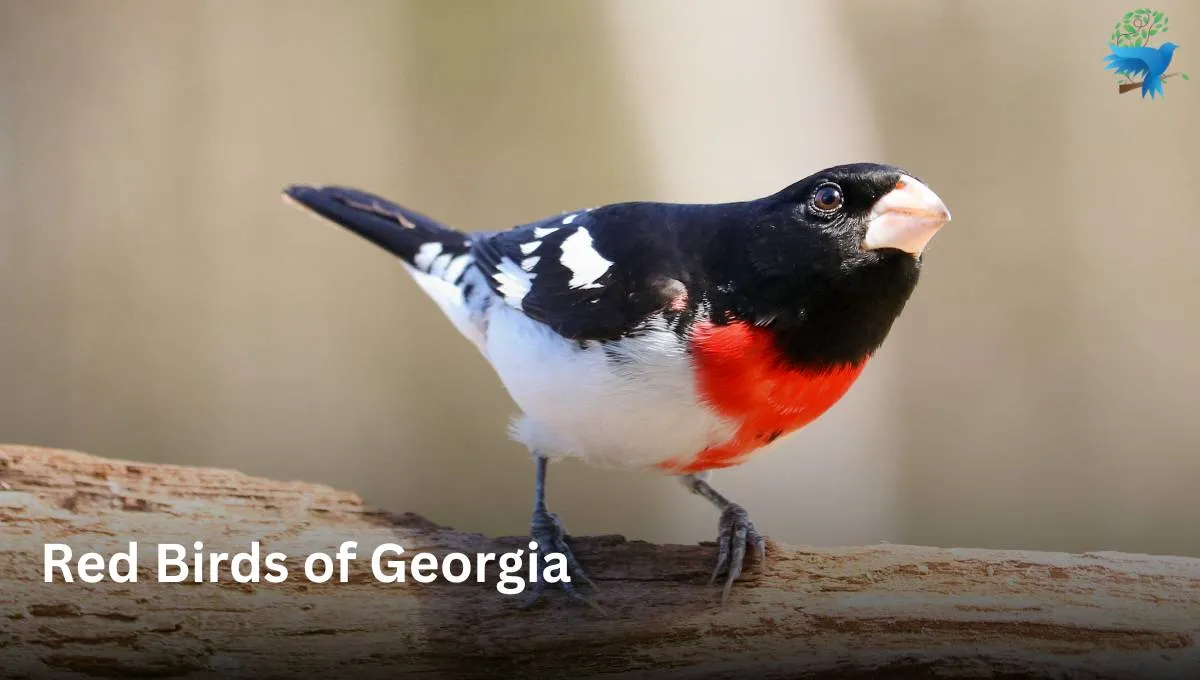
Georgia, a state rich in biodiversity, is home to a variety of red birds. These birds, each with their unique characteristics, habitats, and behaviors, add a vibrant splash of color to the Georgian landscape.
Over 424 species of birds make their way through Georgia, either as year-round residents or as migrants, appearing only during specific times of the year.
However, no matter how common or rare the species, there is something to be enjoyed and admired about each one.
So, take a look at this article, where we explain the seven most recognizable and well-known red birds of Georgia.
List of 7 red birds of Georgia:
- Downy woodpecker
- Red Crossbill
- Red-cockaded woodpecker
- Red-breasted merganser
- Eastern Towhee
- Rose-breasted grosbeak
- Red-tailed hawk
1. Downy woodpecker (Dryobates pubescens)
Downy woodpecker is the smallest species of woodpecker native to North America. This bird is very similar in appearance to the hairy woodpecker, but they are not closely related.
It has mainly black on the upperparts and wings, with a white back, throat, and belly and white spotting on the wings. Also, there is one white bar above the eye and one below.
Males have a red patch on the back of the head, while juvenile birds display a red cap.
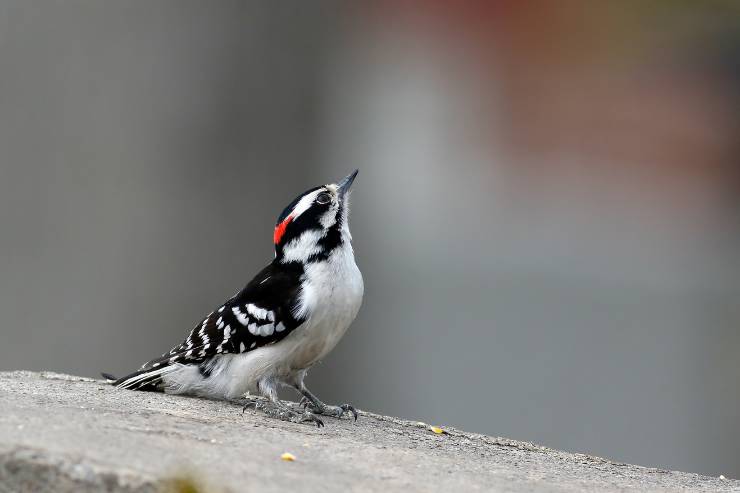
Size and wingspan of Downy woodpecker:
- Size: 14 -18cm (5.5–7.1 inches)
- Wingspan: 25-31 cm (9.8-12.2 inches)
- Weight:20-33g(0.71-1.16 oz)
It is a common year-round resident in Georgia. Whereas it primarily lives in forested areas, throughout the United States and Canada, except for deserts in the southwest and the northern tundra.
It mainly eats insects, but occasionally eats berries, acorns, sap, grains, and suet from birdfeeders.
2. Red crossbill (Loxia curvirostra)
The red crossbill is a sparrow-size bird, that belongs to the finch family Fringillidae. It is also called the Common crossbill in Europe.
Red crossbill males plumage color ranges from dull yellow to bright red, and feathers’ redness is due to the accumulation of feather ketocarotenoid.
On the other hand, females are mostly yellowish below, and brownish, or olive brown above.
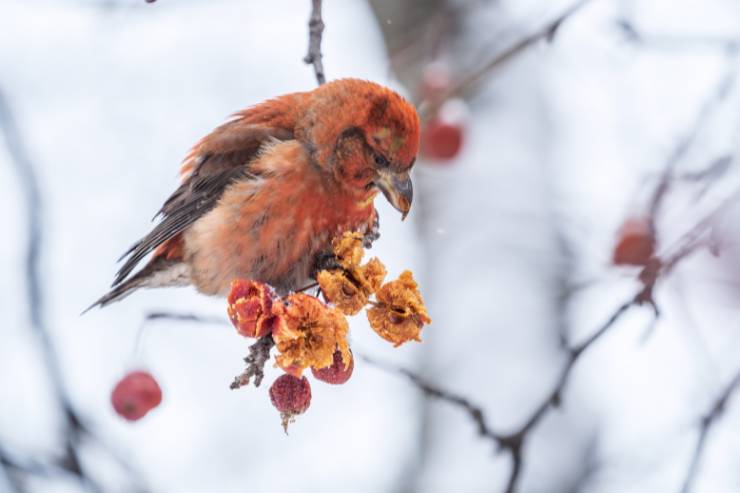
Size and wingspan of Red crossbill:
- Size: 20 cm
- Weight: 40-53g
- Wingspan: 27-29cm
It can be spotted in Georgia all year, but not very frequently. Aside from that, it is also found in large coniferous forests during their breeding season, mostly spruce, pine, hemlock, and Douglas-fir.
However, in winter, they wander wherever they need to go to find food.
The red crossbills are herbivores, they mostly eat the seeds of conifers, but will also consume the buds of trees, weed seeds, berries, and aphids.
3. Red-cockaded woodpecker (Leuconotopicus borealis)
The red-cockaded woodpecker is a small mid-sized species, endemic to the southeastern United States.
This bird’s back is barred with black and white horizontal stripes. Its most distinguishing feature is a black cap and nape that encircles large white cheek patches.
Rarely visible, except perhaps during the breeding season and periods of territorial defense, the woodpecker males have a small red streak on each side of their black cap called a cockade, hence their name.
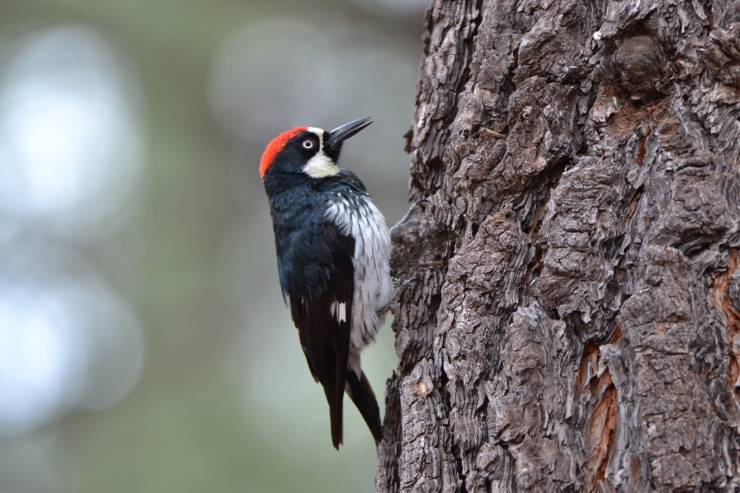
Size and Weight of Red-cockaded woodpecker:
- Size: 18-23cm (7.1-9.1 inches)
- Weight: 40-56g (1.4-2.0oz)
- Wingspan: 34-41 cm (13–16 inches)
The red-cockaded woodpecker is found in Georgia, but rarely. Aside from that, they are also found in a patchy distribution from Virginia south to Florida and west to Arkansas, Oklahoma, and Texas.
Its diet mostly consists of insects such as caterpillars, beetles, ants, and sometimes fruit and berries.
4. Red-breasted merganser (Mergus serrator)
The Red-breasted merganser, scientifically known as, Mergus serrator, is a duck species that is native to much of the Northern Hemisphere.
It has a spiky crest and long thin red bill with serrated edges. Whereas, the male has a dark head with a green sheen, a white neck with rusty breasts, a black back, and white underparts.
Likewise, the Red-breasted merganser females have a rusty head and a grayish body. Also, juveniles look similar to females, but lack the white collar and have smaller white wing patches.
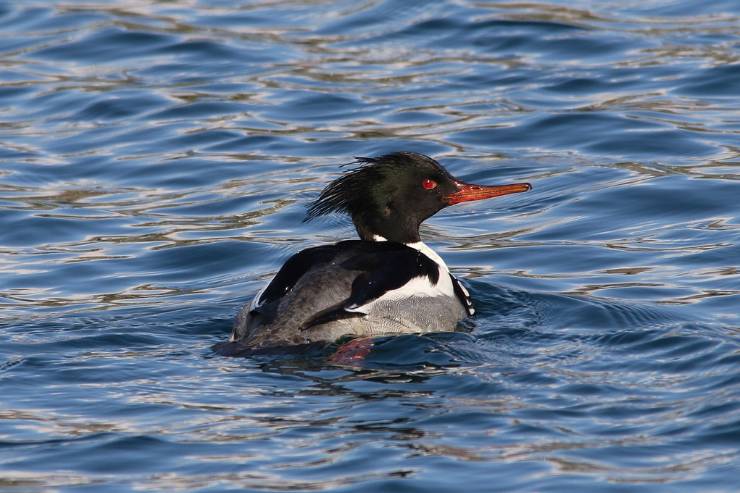
Size and wingspan of Red-breasted merganser:
- Size: 51–64 cm (20–25 inches)
- Wingspan: 66-74 cm (26–29 inches)
- Weight: 800-1350 g(28-48 oz)
It is seen in Georgia during winter months. They breed across northern North America, Greenland, Paleartic, and Europe. In winter, they mainly occur in saltwater, in coastal bays, estuaries, and other protected coastal areas.
This bird dives and swims underwater. They mostly feed on small fish but also add aquatic insects, crustaceans, worms, and amphibians to their diet.
5. Eastern towhee (Pipilo erythropthalmus)
Eastern towhee is a large New World sparrow. It breeds in brushy areas across eastern North America.
The eastern towhee males are sooty black above and on the breast, with warm rufous sides and white on the belly.
Whereas, females have the same pattern but are rich brown where the males are black.
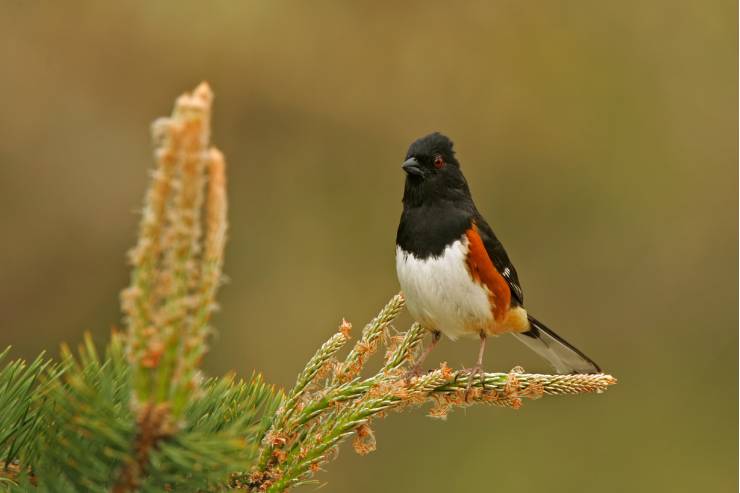
Size and wingspan of Eastern Towhee:
- Size: 17.3-23 cm (6.8-9.1 inches)
- Weight: 40g (1.4 oz)
- Wingspan: 20-30 cm (7.9-11.8 inches)
It occurs throughout the eastern United States and southeast Canada. Also, it inhabits forest edges, old-field successional vegetation, and shrubby areas.
They are active during the day and spend the majority of their time near the ground.
These birds are omnivores and eat a variety of plant and animal matter. Their diet such as seeds and fruits, invertebrates, and sometimes small amphibians, lizards, and snakes.
6. Rose-breasted grosbeak (Pheucticus ludovicianus)
Rose-breasted grosbeak is a large, seed-eating bird in the cardinal family. It is colloquially called”cut-throat” due to its coloration.
This bird is primarily a foliage gleaner and can live up to 24 years in captivity. Rose-breasted grosbeak males are black and white birds with a brilliant red chevron extending from the back throat down the middle of the breast.
While females and immature are brown and heavily streaked, with a bold whitish stripe over the eye. Females flash yellowish whereas males flash pink-red under the wings. Also, both sexes show white patches on the wings and tail.
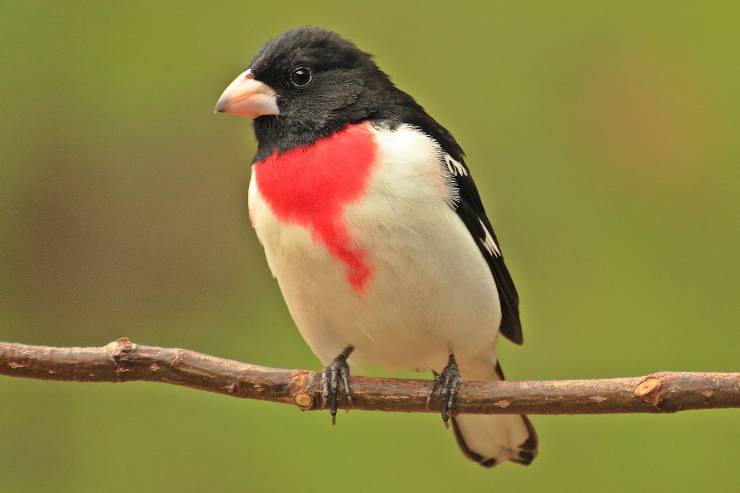
Size and wingspan of Rose-breasted grosbeak:
- Size: 18-22 cm (7.1-8.7 inches)
- Wingspan: 29-33 cm (11–13 inches)
- Weight: 35-65 g (1.2-2.3oz)
It inhabits open deciduous forests, mixed forests, and forest edges next to streams, marshes, ponds, gardens, parks, and plantations. They breed across most of Canada and the northeastern United States.
They primarily consist of insects, berries, fruits, seeds, blossoms, flowers, and on occasion nectar.
7. Red-tailed hawk (Buteo jamaicensis)
The red-tailed hawk is a predatory bird. It is one of three species colloquially known in the United States as the “chickenhawk“, though it rarely preys on standard-sized chickens.
It is not entirely red. However, it gets its name from its reddish-brown tail, which is most visible when the bird is in flight.
Most red-tailed hawks are rich brown above and pale below, with a streaked belly and on the wings underside, a dark bar between shoulder and wrist.
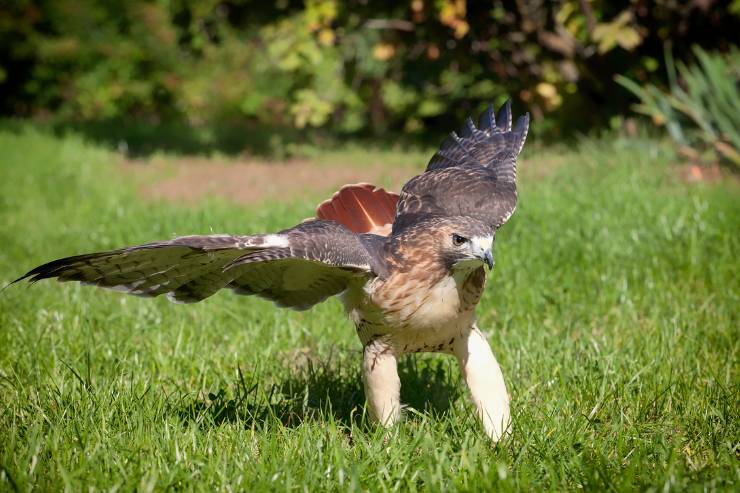
Size and wingspan of Red-tailed hawk:
- Size: 45-65cm (18–26 inches)
- Weight: 690-1600g (1.5-3.5 lb)
- Wingspan: 110-141 cm (3 feet 7 inches-4 feet 8 inches)
This bird exhibits sexual dimorphism in size, with females averaging about 25% heavier than males.
It is a magnificent bird that can be observed in Georgia throughout the year. Also, it is one of the most common hawks in North America. Besides that, Red-tailed hawks can be seen in forests, deserts, grasslands, and even urban areas.
They are carnivores, and their diet varies with the location and the season. They consume small mammals including rats, voles, rabbits, and ground squirrels.
Likewise, reptiles, especially snakes, frogs, bats, and insects are frequently on their menu as well.
Conclusion
Georgia diverse habitats support a wide variety of bird species, including several red birds.
Downy woodpecker, Red-breasted merganser, and Red-tailed hawk are among the most notable red birds in the state.
Whether you’re a birdwatcher or just a nature lover, the vibrant red birds of Georgia offer a delightful slight and fascinating study of nature diversity. So, the next time you’re in Georgia, do not forget to look out for these beautiful red birds.






